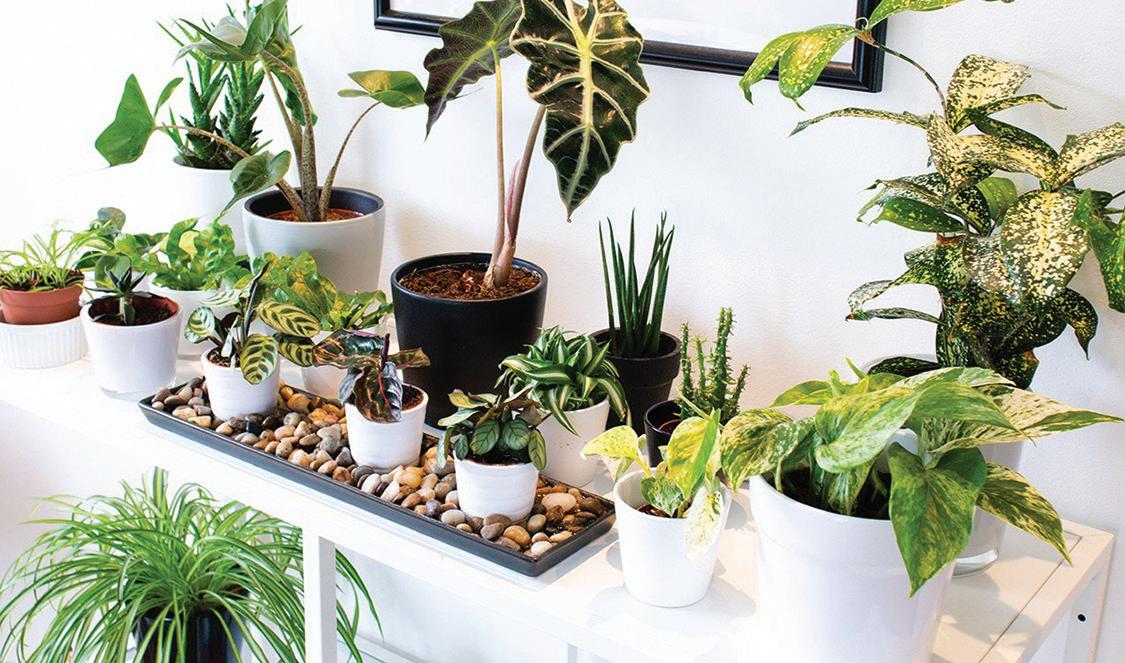
9 minute read
Tidewater Gardening - Houseplant Care: K. Marc Teffeau
TIDEWATER GARDENING by K. Marc Teffeau, Ph.D.
Inside Houseplant Care for 2021
Well, we have entered 2021. What will this new year bring? Hopefully not all the challenges we faced in 2020. Moving into the new year, however, it is encouraging to know that some things, like basic horticultural practices, do not change. Take houseplant care, for example.
During the winter, our interests turn indoors to our houseplants and their care. Don’t fertilize houseplants a lot during winter. They don’t need it. Because your plants tend to grow less during winter, they “eat” less. Feed them only when they are making visible growth. As they perk up in late winter (February), gradually increase

Tidewater Gardening
their food supply. Any houseplant fertilizer will do, but be sure to use it according to the manufacturer’s directions.
Excessive fertilization can result in salt buildup in the soil that may cause root problems. If you are growing plants in clay pots, excessive salts will show up as a white deposit on the outside of the pot. Also, watch your watering. Depending on your plant’s location in the house, it may require differing watering practices depending on the environmental conditions it is exposed to. If the plant in question is growing in a cool, north-facing room, it will need less water than in a living room, den, or family room where a wood stove is located and used.
If your plant’s leaves turn yellow and drop from the bottom toward the top, it may be suffering from overwatering, the number-


410-822-8866 www.riodelmarent.com Rt. 50 at Rt. 565, 2 mi. South of Easton
SALES - PARTS - SERVICE




RIO DEL MAR ENTERPRISES

LOOK FOR US IN OUR NEW LOCATION! The former Salisbury Pewter building, Rt. 50 - 2 miles south of Easton
Tidewater Gardening
one cause of death in houseplants. Sometimes, this condition results from overwatering because the plant is sitting in too large a pot. In this case, excess soil around the roots holds too much water, leading to low oxygen levels and root rot. To avoid this problem, never put a plant into a pot more than 1 to 2 inches wider than the root ball. Wilting can be caused by too much water, too little water, or over-fertilization. Leaves with brown edges may be a sign of chronic underwatering or periodic episodes of severe drying out.
Some of us will have received gift plants for Christmas, ranging from the traditional poinsettia to more exotic types such as cyclamen and Christmas cactus. Your green holiday plants can continue to provide good cheer well into the new year, provided you give them the proper care and attention. You need to remember that Christmas plants have been grown under ideal conditions in greenhouses. Although we cannot duplicate these conditions in the average home, we can still provide for the basic needs of the plants.
The atmosphere in the average home is usually hot and dry, especially if you have a woodstove or forced air heat. This dryness can shorten the life of your plant unless extra humidity is provided. It isn’t easy to increase the humidity in the house, but there are a few tricks you can try. Grouping your plants together helps to raise humidity,


along with frequent misting with a spray bottle or setting plants on water-filled pebble trays. You may have higher humidity in the kitchen and bathroom. Proper watering remains a must throughout the winter. As a general rule, though, you’ll need to water less than in summer because of normally lower room temperatures, less light and slower plant growth. Remember not to water on a schedule but on an asneeded basis.
Your plant should receive plenty of light. Light is always a critical factor for houseplants, but especially so during the low light levels in the winter months. Be aware of each plant’s light needs, and provide accordingly. A sunny windowsill is a good location, but be careful that the foliage doesn’t touch the cold windowpane and get frostbitten. Remember that flowering plants require the highest light exposure. When natural light is lacking, you may have to provide more from artificial sources.
We like to keep our homes warm and cozy during the wintertime, but sometimes it’s a bit too much for indoor plants. Most do well at normal room temperatures (68–72 degrees F) during the day but like it about 10 degrees cooler at night. During the 1970s energy crisis, everybody turned their thermostats down and the houseplants did a whole lot better. Be sure to avoid placing the plants close to heat registers, fire-
FRANK E.DAFFIN, INC. Quality Builders Since 1936

410-822-2364 MHIC #1857 MHBR #877
frankedaffininc.com · fedaffin@atlanticbb.net
Tidewater Gardening
places and woodstoves, and make sure they are not exposed to drafts from around windows, doors or heating vents. Once you decide on a suitable location for a plant, keep it there. Moving it around forces it to readjust to its new environment. Dropping flowers or leaves is usually the first sign of readjustment.
While some Christmas gift plants require special care, others can’t be expected to be “revived” once their blooms have fallen. The Christmas begonia, cyclamen, azalea, Christmas pepper and Jerusalem cherry should be discarded after the blossoms or fruit drop. Remember that the fruit of the Jerusalem cherry is poisonous. Its miniature tomatolike fruit might provide inviting to younger children, so keep it away from children and pets.
Three plants that can be kept after the holidays are the Christ-

QUALITY STROKES PAINTING
Interior & Exterior · Commercial & Residential Free Estimates
Michael Marshall 508 August Street Easton, MD
M.H.I.C. #35075 Phone: 410-714-6000 Fax: 410-822-4795 qstroke@yahoo.com
Tidewater Gardening
mas cactus, the kalanchoe and the poinsettia. If you would like to try to keep your poinsettia for flowering the following Christmas, place it a dimly lighted room once the bracts or “petals” drop and water it only enough to keep its roots moist. Don’t be upset if all the leaves yellow and drop. The plant needs to go through a resting period.
In mid-April, prune the stems back to a 6- or 8-inch length, leaving only 2 or 3 nodes or joints per stem. Water the plant regularly and place it in a sunny window. When all danger of frost is past, repot your poinsettia in a clay pot, using a quality bagged soil for houseplants, and then plunge the pot into the ground in a sunny spot in your garden. Make sure that the rim of the clay pot is buried, or the rim will act as a wick, drying out the soil in the pot and the surrounding soil. Mulch the area around the poinsettia and feed it lightly. Prune back any overly aggressive shoots.

C. ALBERT MATTHEWSINC. Where Integrity Meets Innovation CARRIER 360° ENERGY AUDIT WATER PURIFICATION SYSTEMS PLUMBING-HEATING-AIR CONDITIONING GEOTHERMAL-SOLAR-NEW INSTALLATION ELECTRICAL-REPAIR & MAINTENANCE EFFICIENCY-SAFETY-COMFORT WWW.CALBERTMATTHEWSINC.COM 410-822-0900
In September, bring your plant inside. Beginning the 1st of October, give your poinsettia at least 14 hours of darkness a day for 40 days in a row by placing it in a closet from 5 p.m. until 8 a.m. Any interruption of this schedule will delay flowering. You should start to see color in the bracts by Thanksgiving. Touch the soil surface daily. When it feels dry to the touch, water it thoroughly enough to allow water to drain out the bottom of the pot. Keep the plant in a cool room with plenty of light exposure. With a little bit of work, you will be rewarded with a flowering poinsettia again at next year’s holiday season.
If you use your wood stove this winter, remember that wood ashes are a good potassium fertilizer source when used correctly. Because of their alkaline nature, wood ashes will raise soil pH. Use them in the garden only if a soil test shows a pH level under 7.0. Do not apply wood ashes around “acid-loving” plants. The safe rate of wood ash application to lawn or gardens is 15 to 20 lbs. (approximately a fivegallon pail) per 1,000 square feet per year. Another alternative is to sprinkle them over the compost pile at different times during the winter. Remember, a little wood ash is beneficial, but a lot is not. Also, remember to store the cold ashes in a covered metal container outside the house. Every year we read in the newspaper about house fires
Tidewater Gardening
caused by incorrectly stored hot ashes and coals.
Don’t forget to recycle your holiday greenery in the garden. Wreaths and branches stripped from Christmas trees make excellent mulch for protecting newly planted ornamentals. Remove the material in the

Beall Appraisal Service, LLC

Antiques :: Decorative Arts :: Household Contents
Down-Sizing, Estate Planning, Insurance, Charitable Contribution & Probate Claiborne B. Beall, ASA
Serving Maryland’s Eastern Shore BeallAppraisals.com Call 410-271-6069


Tidewater Gardening
spring and compost it.
We will not get by this winter without some snowfall and ice. If you plan to use salt to melt ice on walks and driveways, spread it carefully to avoid damage to nearby shrubs. Damage to needle-type evergreens will be evident next spring when they exhibit copper- and yellow-toned needles. Damaged deciduous plants will have bronze or reddish leaves. Alternatives to salt include sand or sawdust. Some publications suggest spreading granulated fertilizer, but in my experience, chemical fertilizers stain carpets when carried inside on shoes. They are also salts and can lead to the same damage problems as regular deicing salt if not use correctly.
Happy Gardening!
Marc Teffeau retired as Director of Research and Regulatory Affairs at the American Nursery and Landscape Association in Washington, D.C. He now lives in Georgia with his wife, Linda.
EASTERN SHORE
TITLE COMPANY e Mid-Shore’s Leader in Real Estate Title Services “Why settle for less when you can settle with the best!”

Melissa Grimes-Guy Photography 114 North West Street | Easton, MD 21601 410.820.4426 | www.easternshoretitle.com











